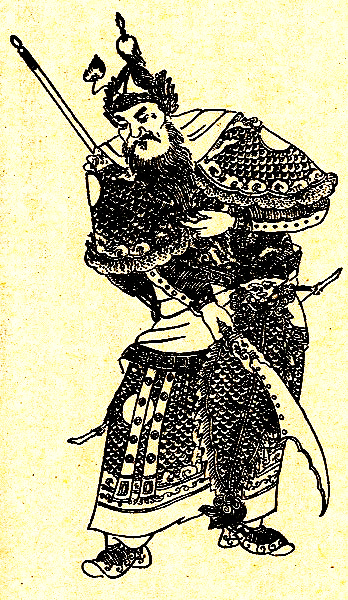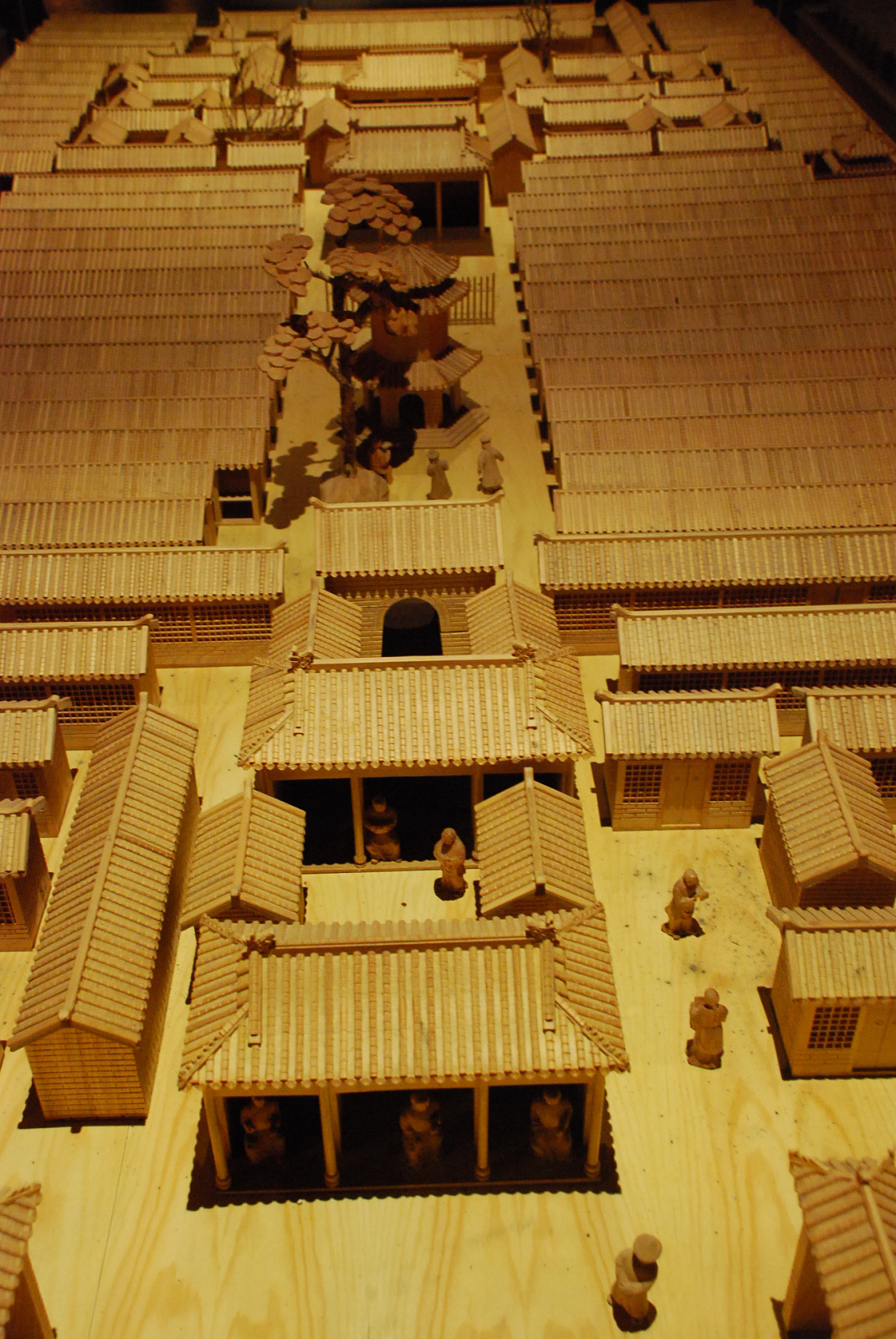|
Huang Chao
Huang Chao (835 – July 13, 884) was a wealthy Chinese salt trader and soldier who is primarily known for instigating the Huang Chao Rebellion. In 878, he proclaimed himself emperor and the establishment of a new Qi dynasty. Huang Chao's rebellion severely weakened and almost defeated the Tang dynasty had he not been betrayed and assassinated by one of his own trusted nephews who had been bribed with money and positions of power by the Tang government. Huang Chao had worked many years as a salt trader before joining Wang Xianzhi's rebellion against the Tang dynasty in the mid-870s. After splitting with Wang, his army turned south and conquered Guangzhou. In 881, his troops captured the Tang capital Chang'an, forcing Emperor Xizong of Tang to flee. Huang Chao then took the throne and reigned for almost four years, but was eventually defeated in battle by Tang army led by the Shatuo chieftain Li Keyong in 883 and forced to desert and escape Chang'an. Following successive de ... [...More Info...] [...Related Items...] OR: [Wikipedia] [Google] [Baidu] |
Huang (surname)
Huang (; zh, t=Wiktionary:黃, 黃, s=wikt:黄, 黄, c=, p=, first=t) is a Chinese surname. While ''Huáng'' is the pinyin romanization of the word, it may also be romanized as Hwang (Korean surname), Hwang, Wong (surname), Wong, Waan, Wan, Waon, Hwong, Vong, Hung, Hong, Bong, Eng, Ng (name), Ng, Uy (surname), Uy, Wee, Oi, Oei, Oey, Ooi, Ong, or Ung due to pronunciations of the word in different dialects and languages. It is the 96th name on the ''Hundred Family Surnames'' poem.K. S. Tom. [1989] (1989). Echoes from Old China: Life, Legends and Lore of the Middle Kingdom. University of Hawaii Press. . This surname is known as Hwang (Korean name), Hwang in Korean language, Korean. In Vietnamese language, Vietnamese, the name is known as Hoàng or Huỳnh. Huang is the 7th most common surname in China. Hoang/Huynh is the 5th most common surname in Vietnam. The population of Huangs in China and Taiwan was estimated at more than 35 million in 2020; it was also the surname of more tha ... [...More Info...] [...Related Items...] OR: [Wikipedia] [Google] [Baidu] |
An Lushan
An Lushan (; 20th day of the 1st month (19 February) 703 – 29 January 757) was a Chinese military general and rebel leader during the Tang dynasty and is primarily known for instigating the An Lushan Rebellion which devastated China and killed millions of people. An Lushan was of Sogdian and Göktürk origin,Yang, Zhijiu, "An Lushan". ''Encyclopedia of China'' (Chinese History Edition), 1st ed.Lin, TianweAn Lushan profile, ''Chinese Encyclopedia'' (Biography Edition; 1st ed.); accessed 3 August 2011.Zhong, Han. "Ah Lushan Dengzahu De Neiya Wenhua Beijing" ("The Cultural Background on An Lushan, etc in Inner Asia — With the Discussion on the Inner Asia-ized of Sute or Sogdian"). ''Journal of Chinese Historical Studies'' (2005); at least by adoption. He rose to prominence as a general by defending the northeastern Tang frontier from the Khitans and other threats. Through his frequent visits to Chang'an, the Tang capital, An Lushan managed to gain favour with Emperor Xuanzo ... [...More Info...] [...Related Items...] OR: [Wikipedia] [Google] [Baidu] |
Jiaozuo
Jiaozuo ( zh, s= , p=Jiāozuò ; postal: Tsiaotso) is a prefecture-level city in the northwest of Henan province, China. Sitting on the northern bank of the Yellow River, it borders the provincial capital of Zhengzhou to the south, Xinxiang to the east, Jiyuan to the west, Luoyang to the southwest, and the province of Shanxi to the north. Jiaozuo is one of the core cities of the Central Plains urban agglomeration and a regional central city along the Shanxi–Henan border area. Its population was 3,590,700 as of the 2018 estimate whom 1,424,500 lived in the built-up area made of 4 urban districts ( Jiefang, Shanyang, Zhongzhan and Macun) and Bo'ai County largely being urbanized. Administration The prefecture-level city of Jiaozuo administers 4 districts, 2 county-level cities and 4 counties. * Jiefang District * Shanyang District * Zhongzhan District * Macun District * Qinyang City * Mengzhou City *Xiuwu County * Wuzhi County * Wen County * Bo'ai County History ... [...More Info...] [...Related Items...] OR: [Wikipedia] [Google] [Baidu] |
Empress Cao (Huang Chao's Wife)
Empress Cao (曹皇后, personal name unknown) (died July 13, 884?Academia Sinicabr>Chinese-Western Calendar Converter''Zizhi Tongjian'', vol. 256.The account in Huang Chao's biography in the ''New Book of Tang'', adopted into the ''Zizhi Tongjian'', indicated that his wife — presumably Empress Cao, although she was not referred to by name — was killed at the same time that he was, but does not conclusively show that the reference was to Empress Cao. See ''New Book of Tang'', vol. 225, part 2. Huang's biography in the ''Old Book of Tang'' had a contrary account — that Huang's wife, after Huang's death, was delivered to the Tang general Shi Pu. See ''Old Book of Tang'', vol. 200, part 2.) was the wife of Huang Chao, a major agrarian rebel against the rule of the Chinese Tang dynasty during the reign of Emperor Xizong. Nothing is known about the future Empress Cao's background, including when she married Huang or whether she bore any children for Huang. The only firm hist ... [...More Info...] [...Related Items...] OR: [Wikipedia] [Google] [Baidu] |
Imperial Examination
The imperial examination was a civil service examination system in History of China#Imperial China, Imperial China administered for the purpose of selecting candidates for the Civil service#China, state bureaucracy. The concept of choosing bureaucrats by merit rather than by birth started Imperial examination in Chinese mythology, early in Chinese history, but using written examinations as a tool of selection started in earnest during the Sui dynasty (581–618), then into the Tang dynasty (618–907). The system became dominant during the Song dynasty (960–1279) and lasted for almost a millennium until its abolition during the late Qing reforms, late Qing dynasty reforms in 1905. The key sponsors for abolition were Yuan Shikai, Yin Chang and Zhang Zhidong. Aspects of the imperial examination still exist for entry into the civil service of both China and Taiwan. The exams served to ensure a common knowledge of writing, Chinese classics, and literary style among state officials. ... [...More Info...] [...Related Items...] OR: [Wikipedia] [Google] [Baidu] |
New Book Of Tang
The ''New Book of Tang'', generally translated as the "New History of the Tang" or "New Tang History", is a work of official history covering the Tang dynasty in ten volumes and 225 chapters. The work was compiled by a team of scholars of the Song dynasty, led by Ouyang Xiu and Song Qi. It was originally simply called the ''Tangshu'' (唐書, Book of Tang) until the 18th century. History In Chinese history, it was customary for dynasties to compile histories of their immediate predecessor as a means of cementing their own legitimacy. As a result, during the Later Jin (Five Dynasties), Later Jin dynasty of the Five Dynasties and Ten Kingdoms period, a history of the preceding Tang dynasty, the ''Old Book of Tang'' () had already been compiled. In 1044, however, Emperor Renzong of Song ordered a new compilation of Tang history, based on his belief that the original ''Old Book of Tang'' lacked organization and clarity. The process took 17 years, being finally completed in 1060. ... [...More Info...] [...Related Items...] OR: [Wikipedia] [Google] [Baidu] |
Shandong
Shandong is a coastal Provinces of China, province in East China. Shandong has played a major role in Chinese history since the beginning of Chinese civilization along the lower reaches of the Yellow River. It has served as a pivotal cultural and religious center for Taoism, Chinese Buddhism and Confucianism. Shandong's Mount Tai is the most revered mountain of Taoism and a site with one of the longest histories of continuous religious worship in the world. The Buddhist temples in the mountains south of the provincial capital of Jinan were once among the foremost Buddhist sites in China. The city of Qufu was the birthplace of Confucius, and later became the center of Confucianism. Shandong's location at the intersection of ancient and modern north–south and east–west trading routes has helped establish it as an economic center. After a period of political instability and economic hardship beginning in the late 19th century, Shandong has experienced rapid growth in recent de ... [...More Info...] [...Related Items...] OR: [Wikipedia] [Google] [Baidu] |
Heze
Heze (), formerly known as Caozhou, is the westernmost prefecture-level city in Shandong province, China, bordering Jining to the east and the provinces of Henan and Anhui to the west and south respectively.The total area is 12238.62 square kilometers and the population is 10.58 million. It governs Mudan District and Dingtao District, 2 districts and 7 counties including Caoxian, Chengwu, Shanxian, Juye, Yuncheng, Juancheng and Dongming. There are more than 100 cultural relics and historic sites in the territory, 6 national-level cultural relics protection units, and 52 provincial-level cultural relics protection units. Places of interest include Caozhou Peony Garden, Yuncheng Water Margin, Sunbin Tourist City, Dingtao Han Tomb, Shanxian Archway, Jinshan Mountain, Fangshan Mountain, Fulong Lake, the scenery of the old Yellow River route, etc. History Caozhou was at the center of the Nian Rebellion during the 1850s and 60s. In August 1949, Heze was detached from Shandong and giv ... [...More Info...] [...Related Items...] OR: [Wikipedia] [Google] [Baidu] |
Mudan District
Mudan District is an urban district of Heze, Shandong Shandong is a coastal Provinces of China, province in East China. Shandong has played a major role in Chinese history since the beginning of Chinese civilization along the lower reaches of the Yellow River. It has served as a pivotal cultural ... province. It is the seat of Heze's prefectural government and center of its built-up or metro area, bordering Henan province to the northwest across the Yellow River. History Southwest Mudan District was the site of the ancient and medieval town of Yuanqu, which was the seat of an eponymous county. Administrative divisions , this County is divided to 10 subdistricts, 12 towns and 2 townships. ;Subdistricts ;Towns ;Townships * Huji Township () * Huangzhen Township () Transportation * Heze railway station References External links Official site {{authority control County-level divisions of Shandong Heze ... [...More Info...] [...Related Items...] OR: [Wikipedia] [Google] [Baidu] |
Yuanqu County (Shandong)
Yuanqu or Wanqu County, known as after 1086, was a former Chinese county, county of imperial China covering most of present-day Dongming County and the western part of Mudan District in the Heze Prefecture of southwestern Shandong. Yuanqu or Wanqu was also the name of its eponymous county seat. The town was destroyed by a flood of the Yellow River in 1168, and its territory merged with Jiyin County. The ruins of the county seat were rediscovered at Longwangmiao Village in southwestern Mudan District in June 2007 by a team of Archaeology of China, archaeologists from the district government. Name ''Yuānqú'' is the pinyin romanization of Chinese, romanization of the present Standard Mandarin, Mandarin pronunciation of the Chinese language, Chinese Chinese placenames, placename . Because the Chinese characters, character is now usually pronounced ''jù'' in its sense of "phrase" or "Sentence (linguistics), sentence", the town and county's name is frequently misread as ''Yuānj� ... [...More Info...] [...Related Items...] OR: [Wikipedia] [Google] [Baidu] |


